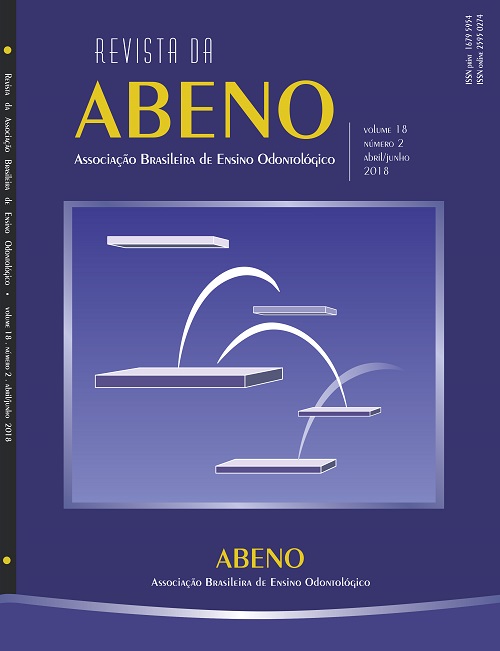Burnout Syndrome among Dental professors: a cross-sectional study
DOI:
https://doi.org/10.30979/rev.abeno.v18i2.557Keywords:
Dental Faculty. Dentistry. Higher Education. Stress, Psychological. Professional Burnout.Abstract
Burnout Syndrome (BS) is characterized by stress and exhaustion related to work and affects professionals from different fields. The purpose of this study was to evaluate the prevalence of BS among professors of a Brazilian Dental School and to investigate whether there are sociodemographic factors associated with this condition. Forty-eight out of 72 dental professors (66.7%) participated in the survey. Data were collected through a sociodemographic questionnaire adapted from the Copenhagen Burnout Inventory (CBI), which analyzes this condition in four dimensions: personal burnout (PB), work-related burnout (WRB), coworker-professor-related burnout (CWPRB) and patient-related burnout (PRB). Descriptive analysis, Student’s t-test and ANOVA test were performed. Among the responders, 60.4% had graduated from a Dental School more than 15 years, and 64.6% worked as clinical professors. The highest average scores corresponded to dimensions WRB (2.51) and PB (2.43), while the lowest was related to CWPRB (1.96) and PRB (1.81). Scores were not related to gender, time since graduation or years of teaching experience. Most subjects rated working conditions as "regular" (43.7%) and "poor" (29.2%), with significant differences concerning the variable materials and equipment. In conclusion, some respondents have shown a trend to present BS, above all in the PB and WRB dimensions. Similar studies should be performed in different Dental Schools to know the syndrome presence and prevent its development or progression.Downloads
References
Noh JW, Kim J, Park J, Kim HJ, Kwon YD. Gender difference in relationship between health-related quality of life and work status. PLoS One. 2015;10(12):e0143579.
Reid C, Riddick-Grisham S. The importance of work or productive activity in life care planning and case management. Neuro Rehabilitation. 2015;36(3):267-74.
Maslach C, Schaufeli WB, Leiter MP. Job burnout. Annu Rev Psychol. 2001;52(1):397-422.
Brandstätter V, Job V, Schulze B. Motivational incongruence and well-being at the workplace: person-job fit, job burnout, and physical symptoms. Front Psychol. 2016;7:1153.
Murphy RJ, Gray SA, Sterling G, Reeves K, DuCette J. A comparative study of professional student stress. J Dent Educ. 2009;73(3):328-37.
Porto GG, Carneiro SC, Vasconcelos BC, Nascimento MM, Leal JL. Burnout syndrome in oral and maxillofacial surgeons: a critical analysis. Int J Oral Maxillofac Surg. 2014;43(7):894-9.
Freudenberger HJ. Staff burn-out. J Soc Issues. 1974;30(1):159-65.
Arvidsson I, Håkansson C, Karlson B, Björk J, Persson R. Burnout among Swedish school teachers - a cross-sectional analysis. BMC Public Health. 2016;16(1):823.
Huri M, Bağiş N, Eren H, Başibüyük O, Şahin S, Umaroğlu M, et al. Burnout and occupational participation among dentists with teaching responsibilities in universities. Psychol Health Med. 2016;22(6):693-700.
Leggat PA, Kedjarune U, Smith DR. Occupational health problems in modern dentistry: a review. Ind Health. 2007;45(5):611-21.
Montiel-Company JM, Subirats-Roig C, Flores-Martí P, Bellot-Arcís C, Almerich-Silla JM. Validation of the Maslach Burnout Inventory-Human Services Survey for estimating burnout in Dental students. J Dent Educ. 2016;80(11):1368-75.
Pau A, Rowland ML, Naidoo S, AbdulKadir R, Makrynika E, Moraru R, et al. Emotional intelligence and perceived stress in dental undergraduates: a multinational survey. J Dent Educ. 2007;71(2):197-204.
Divaris K, Polychronopoulou A, Taoufik K, Katsaros C, Eliades T. Stress and burnout in postgraduate dental education. Eur J Dent Educ. 2012;16(1):35-42.
Chirico F. Job stress models for predicting burnout syndrome: a review. Ann Ist Super Sanita. 2016;52(3):443-56.
Prado RL, Bastianini ME, Cavalleri MZ, Ribeiro SFR, Pizi ECG, Marsicano JA. Assessment of Burnout syndrome in university teachers. Rev ABENO. 2017; 17(3):21-9.
Kristensen TS, Borritz M, Villadsen E, Christensen KB. The Copenhagen Burnout Inventory: a new tool for the assessment of burnout. Work Stress. 2005;19(3):192-207.
Brasil. Doenças relacionadas ao trabalho: Manual de procedimentos para os serviços de saúde. Brasília: Ministério da Saúde, 2001.
Winwood PC, Winefield AH. Comparing two measures of burnout among dentists in Australia. Int J Stress Manag. 2004;11(3):282-89.
Randall KJ. Examining the relationship between burnout and age among Anglican clergy in England and Wales. Ment Health Rel Cult. 2007;10(1):39-46.
Milfont TL, Denny S, Ameratunga S, Robinson E, Merry S. Burnout and wellbeing: testing the Copenhagen Burnout Inventory in New Zealand teachers. Soc Indic Res. 2008;89(1):169–177.
Downloads
Published
How to Cite
Issue
Section
License
Autores que publicam nesta revista concordam com os seguintes termos:
a) Autores mantém os direitos autorais e concedem à revista o direito de primeira publicação, com o trabalho simultaneamente licenciado sob a Licença Creative Commons Attribution que permite o compartilhamento do trabalho com reconhecimento da autoria e publicação inicial nesta revista.
b) Autores têm autorização para assumir contratos adicionais separadamente, para distribuição não-exclusiva da versão do trabalho publicada nesta revista (ex.: publicar em repositório institucional ou como capítulo de livro), com reconhecimento de autoria e publicação inicial nesta revista.
c) Autores têm permissão e são estimulados a publicar e distribuir seu trabalho online (ex.: em repositórios institucionais ou na sua página pessoal) a qualquer ponto antes ou durante o processo editorial, já que isso pode gerar alterações produtivas, bem como aumentar o impacto e a citação do trabalho publicado (Veja O Efeito do Acesso Livre).






